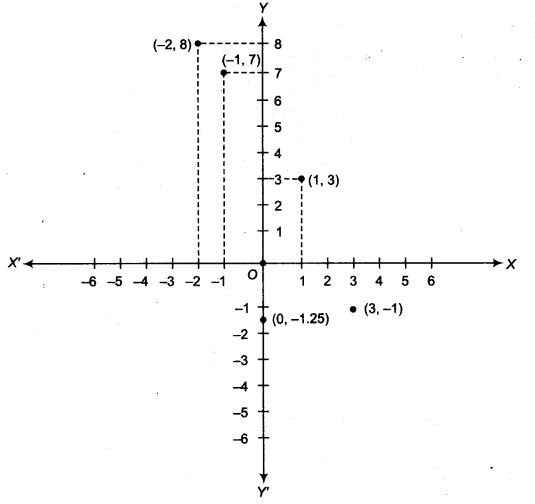Question 1.
How will you describe the position of a table lamp on your study table to another person?
Solution:
Let us consider the lamp as a point A and table as a plane.
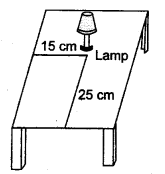
Take any two perpendicular edges of the table, say OX and OY. Measure the distance of the lamp A from the larger edge OX, let it be 25 cm. Again, measure the distance of the lamp A from the shorter edge OY, let it be 15 cm. Therefore, the position of the lamp A to the edges OX and OY is (15, 25).
Question 2.
(Street Plan) A city has two main roads which cross each other at the centre of the city. These two roads are along the North-South direction and East-West direction. All the other streets of the city run parallel to these roads and are 200 m apart. There are 5 streets in each direction. Using 1 cm = 200 m, draw a model of the city on your notebook. Represent the roads/streets by single lines.
There are many cross-streets in your model. A particular cross-street is made by two street one running in the North-South direction and another in the East-West direction. Each cross-street is referred to in the following manner : If the 2 nd street running in the North-South direction and 5th in the East-West direction meet at some crossing, then we will call this cross-street (2, 5). Using this convention, find
- (i) how many cross-streets can be referred to as (4, 3).
- (ii) how many cross-streets can be referred to as (3, 4).
Solution:
(i) The street plan is shown by the following figure.
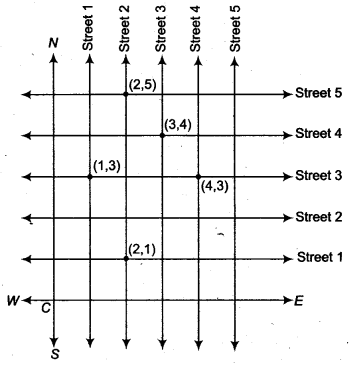
- (i) There is only one cros.s-street which can be referred as (4, 3).
- (ii) There is only one cross-street which can be referred as (3, 4).
Question 1.
Write the answer of each of the following questions
- (i) What is the name of horizontal and the vertical lines drawn to determine the position of any point in the Cartesian plane?
- (ii) What is the name of each part of the plane formed by these two lines?
- (iii) Write the name of the point where these two lines intersect.
Solution:
- (i) Horizontal line is known as X-axis and vertical line is known as y – axis.
- (ii) Each part of the plane formed by horizontal and vertical lines is known as quadrant.
- (iii) Horizontal and vertical lines intersect at the origin.
Question 2.
See figure, and write the following
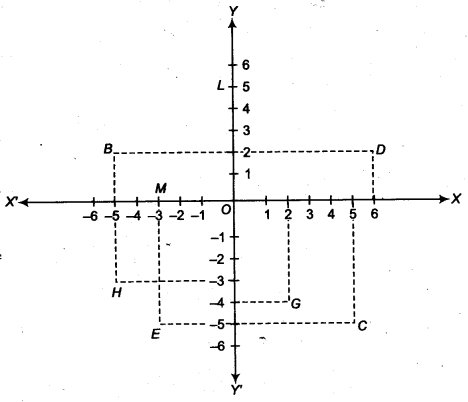
- (i) The coordinates of B.
- (ii) The coordinates of C.
- (iii) The point identified by the coordinates (-3, – 5).
- (iv) The point identified by the coordinates (2, -4).
- (v) The abscissa of the point D.
- (vi) The ordinate of the point H.
- (vii) The coordinates of the point I.
- (viii) The coordinates of the point M.
Solution:
- (i) The coordinates of B = (-5, 2) and 6 lies in ? quadrant.
- (∵ Abscissa = – 5, Ordinate = 2)
- (ii) The coordinates of C = (5, -5).
- (iii) The point identified by the coordinates (- 3, -5) is E.
- (iv) The point identified by the coordinates (2, – 4) is G.
- (v) The abscissa of the point D = 6
- (vi) The ordinate of the point H = – 3
- (vii) The coordinates of the point L = (0,5) (Lies on Y-axis)
- (viii) The coordinates of the point M = (-3,0) (Lies on X-axis)
Question 1.
In which quadrant or on which axis does each of the points (-2,4), (3, – 1), (-1,0), (1, 2) and (-3, – 5) lie? Verify your answer by locating them on the cartesian plane.
Solution:
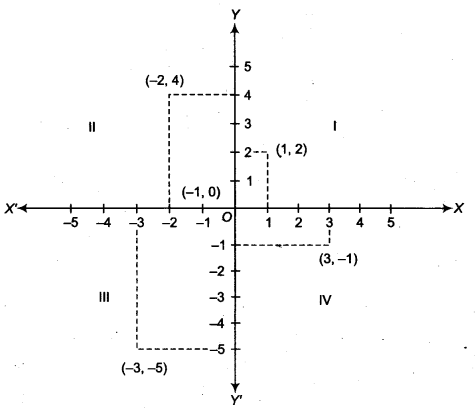
- (i) (-2, 4) lies in II quadrant.
- (ii) (3, -1) lies in IV quadrant.
- (iii) (-1,0) lies on X-axis.
- (iv) (1, 2) lies in I quadrant.
- (v) (-3, -5) lies in III quadrant.
Question 2.
Plot the points (x, y) given in the following table on the plane, choosing suitable units of distance on the axes.

Solution:
Let 1 unit = 1 cm, then positions of given points in the cartesian plane are given below.
